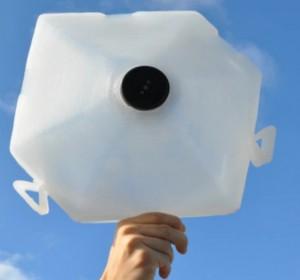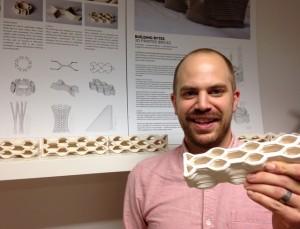Brian Peters is the co-founder of DesignLabWorkshop, and he’s spent the last few years working with 3D printers in his architectural explorations.
As part of a month and a half long residency program at the European Ceramic Work Centre, Peters created and built his take on 3D printed ceramic bricks, and he calls them Building Bytes. It’s essentially a system which uses portable 3D printers as a brick factory for construction projects on-site.
Peters founded DesignLabWorkshop in 2008 as an incubator for research into emergent design and fabrication techniques. After completing his work on a Master’s of Architecture at the University of Illinois at Chicago, he spent 5 years as a working architect there.
As of September 2013, DesignLabWorkshop is now based in Kent, Ohio, and his latest project, the Solar Bytes Pavilion, is an experimental structure meant to highlight the potential for a new 3D printed architecture.
Making use of bleeding edge processes, materials, and technologies, Peters has fabricated a 3D printed structure which incorporates smart technologies like light sensors, photovoltaics, and renewable energy sources like solar power to realize his forward-thinking vision.
The Solar Bytes Pavilion charges itself during the day, and by night, it glows with all the stored solar energy.
Constructed from 94 unique modules — or “bytes” — each of the 3D printed building blocks includes integrated, solar-powered LEDs w ithin their translucent plastic shells which make up the whole of the pavilion.
ithin their translucent plastic shells which make up the whole of the pavilion.
The interlocking bricks feature joints which snap together to provide the pavilion with its support mechanism.
Laid out to track the path of the sun as it travels from east to west across the sky, the solar cells capture and store solar energy as they sense the changing light levels throughout the day. The arrangement basically records the path and intensity of the sun during a given day, and at night as the LEDs begin to light up, they play back a representation of the day’s conditions minute-by-minute.
Peters, an Assistant Professor at the College of Architecture and Environmental Design at Kent State University, uses 3D printing technology to create the individual modules. In this case, he used a 6-axis robot arm located at the Robotic Fabrication Lab at Kent State. A hand welding extruder, called the Mini CS, was attached to the robot arm to serve as the 3D printhead, and it extrudes plastic material in a sort of FDM-style process. The technology, provided by Hapco Inc. and called BAK/DOHLE, is employed by universities, government agencies, and concerns like the University of Michigan, Oak Ridge Laboratory, the US Department of Energy, and the University of Tennessee.
Have you heard of any other projects where architects are using 3D printing technology to push the edges of the envelope? Do you think architects will come up with ways to make the technology critical to the practice of building? Let us know in the Solar Bytes Pavilion forum thread on 3DPB.com.
Subscribe to Our Email Newsletter
Stay up-to-date on all the latest news from the 3D printing industry and receive information and offers from third party vendors.
You May Also Like
Precision at the Microscale: UK Researchers Advance Medical Devices with BMF’s 3D Printing Tech
University of Nottingham researchers are using Boston Micro Fabrication‘s (BMF) 3D printing technology to develop medical devices that improve compatibility with human tissue. Funded by a UK grant, this project...
3D Printing Webinar and Event Roundup: April 21, 2024
It’s another busy week of webinars and events, starting with Hannover Messe in Germany and continuing with Metalcasting Congress, Chinaplas, TechBlick’s Innovation Festival, and more. Stratasys continues its advanced training...
3D Printing Webinar and Event Roundup: March 17, 2024
It’s another busy week of webinars and events, including SALMED 2024 and AM Forum in Berlin. Stratasys continues its in-person training and is offering two webinars, ASTM is holding a...
3D Printed Micro Antenna is 15% Smaller and 6X Lighter
Horizon Microtechnologies has achieved success in creating a high-frequency D-Band horn antenna through micro 3D printing. However, this achievement did not rely solely on 3D printing; it involved a combination...































